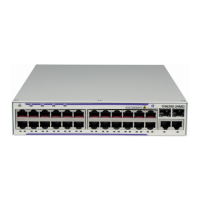Label Distribution Protocol
7210 SAS M, T, X, R6, Mxp MPLS Configuration Guide Page 245
4. A BFD session, enabled on a T-LDP session to a peer, times-out and as a result the link
LDP session to the same peer and which uses the same TCP connection as the T-LDP
session goes also down. In this case, LDP sends a neighbor/next-hop down message to the
IOM for this LDP peer only.
5. A BFD session enabled on the LDP interface to a directly connected peer, times-out and
brings down the link LDP session to this peer. In this case, LDP sends a neighbor/next-
hop down message to the IOM for this LDP peer only. BFD support on LDP interfaces is
a new feature introduced for faster tracking of link LDP peers. See Section 1.2.1 for more
details.
The tunnel-down-dump-time option or the label-withdrawal-delay option, when enabled, does not
cause the corresponding timer to be activated for a FEC as long as a backup NHLFE is still
available.
Link LDP Hello Adjacency Tracking with BFD
LDP can only track an LDP peer with which it established a link LDP session with using the Hello
and Keep-Alive timers. If an IGP protocol registered with BFD on an IP interface to track a
neighbor, and the BFD session times out, the next-hop for prefixes advertised by the neighbor are
no longer resolved. This however does not bring down the link LDP session to the peer since the
LDP peer is not directly tracked by BFD. More importantly the LSR-id of the LDP peer may not
coincide with the neighbor’s router-id IGP is tracking by way of BFD.
In order to properly track the link LDP peer, LDP needs to track the Hello adjacency to its peer by
registering with BFD. This way, the peer next-hop is tracked.
The user enables Hello adjacency tracking with BFD by enabling BFD on an LDP interface:
config>router>ldp>interface-parameters>interface>enable-bfd
The parameters used for the BFD session, i.e., transmit-interval, receive-interval, and multiplier,
are those configured under the IP interface in existing implementation:
config>router>interface>bfd
When multiple links exist to the same LDP peer, a Hello adjacency is established over each link
but only a single LDP session will exist to the peer and will use a TCP connection over one of the
link interfaces. Also, a separate BFD session should be enabled on each LDP interface. If a BFD
session times out on a specific link, LDP will immediately bring down the Hello adjacency on that
link. In addition, if the there are FECs which have their primary NHLFE over this link, LDP
triggers the LDP FRR procedures by sending to IOM the neighbor/next-hop down message. This
will result in moving the traffic of the impacted FECs to an LFA next-hop on a different link to the
same LDP peer or to an LFA backup next-hop on a different LDP peer depending on the lowest
backup cost path selected by the IGP SPF.

